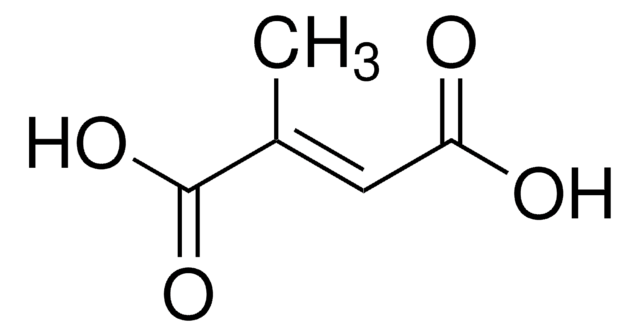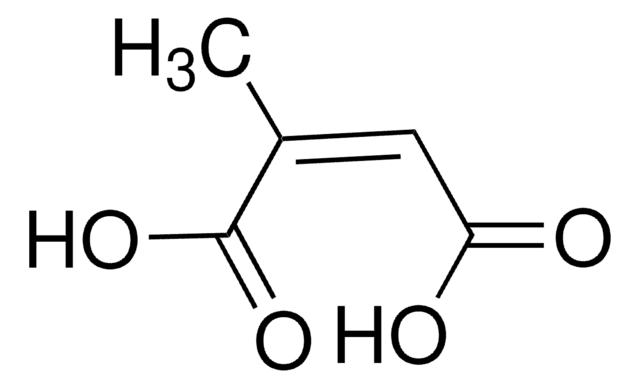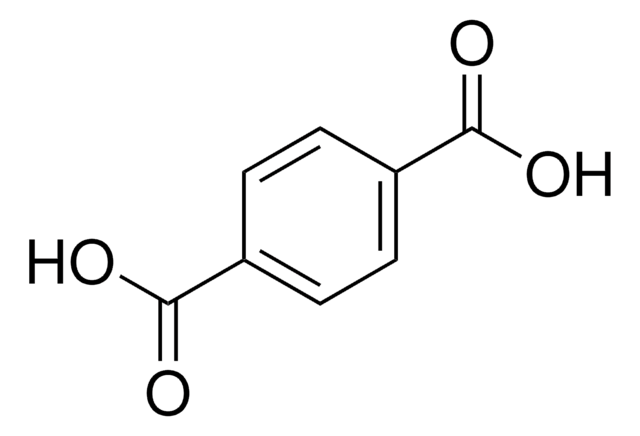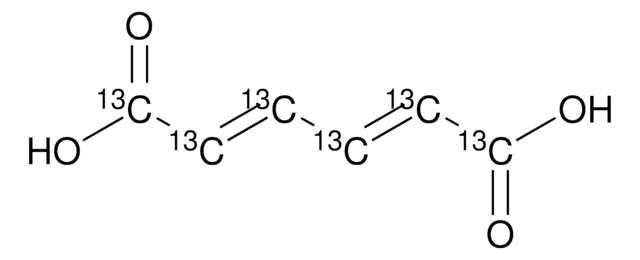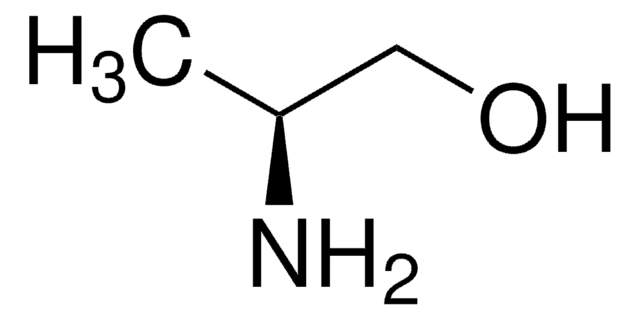15992
cis,cis-Muconic acid
≥97.0% (HPLC)
Synonym(s):
cis,cis-2,4-Hexadienedioic acid
Sign Into View Organizational & Contract Pricing
All Photos(1)
About This Item
Empirical Formula (Hill Notation):
C6H6O4
CAS Number:
Molecular Weight:
142.11
Beilstein:
1722246
MDL number:
UNSPSC Code:
12352100
PubChem Substance ID:
NACRES:
NA.22
Recommended Products
Assay
≥97.0% (HPLC)
mp
194-195 °C (lit.)
functional group
carboxylic acid
SMILES string
OC(=O)/C=C\C=C/C(O)=O
InChI
1S/C6H6O4/c7-5(8)3-1-2-4-6(9)10/h1-4H,(H,7,8)(H,9,10)/b3-1-,4-2-
InChI key
TXXHDPDFNKHHGW-CCAGOZQPSA-N
Related Categories
General description
cis,cis-Muconic acid is a naturally-occurring organic acid. It is also referred as 2E,4E-hexa-2,4-dienedioic acid. It is used in the manufacture of several widely-used consumer plastics. Its microbial production via extending shikimate pathway has been reported.
Application
- Biotechnological production methods: Research highlights various biotechnological approaches to enhance the synthesis of cis,cis-muconic acid, which can serve as a precursor for biodegradable polymers and other bio-based plastics, aligning with sustainable chemical manufacturing goals (Son et al., 2023).
- Industrial application in polymer industry: The potential application of cis,cis-muconic acid in the polymer industry is explored, focusing on its role as a precursor for manufacturing eco-friendly, bio-based plastics, thereby contributing to sustainable industrial practices (Palumbo et al., 2024).
Signal Word
Warning
Hazard Statements
Precautionary Statements
Hazard Classifications
Acute Tox. 4 Oral - Eye Irrit. 2 - Skin Irrit. 2 - STOT SE 3
Target Organs
Respiratory system
Storage Class Code
11 - Combustible Solids
WGK
WGK 3
Flash Point(F)
Not applicable
Flash Point(C)
Not applicable
Personal Protective Equipment
dust mask type N95 (US), Eyeshields, Gloves
Choose from one of the most recent versions:
Already Own This Product?
Find documentation for the products that you have recently purchased in the Document Library.
Customers Also Viewed
Ahmad A Deeb et al.
Analytical and bioanalytical chemistry, 408(16), 4219-4232 (2016-04-22)
The presence of organic micropollutants and their transformation products (TPs) from biotic and abiotic processes in aquatic environments is receiving intense public and scientific attention. Yet a suitable sample preparation method that would enable extraction and enrichment of a wide
Arnon Setsungnern et al.
Plant physiology and biochemistry : PPB, 120, 95-102 (2017-10-11)
Benzene, a carcinogenic compound, has been reported as a major indoor air pollutant. Chlorophytum comosum (C. comosum) was reported to be the highest efficient benzene removal plant among other screened plants. Our previous studies found that plants under light conditions could
Bo Wang et al.
Journal of hazardous materials, 373, 29-38 (2019-03-23)
Phenol is a common water pollutant because of its broad industrial applications. Biological method is a promising alternative to conventional physical and chemical methods for removing this toxic pollutant from the environment. In this study, two metabolic modules were introduced
Jing Sun et al.
Journal of biotechnology, 280, 49-54 (2018-06-10)
Adipic acid (AA) is an important dicarboxylic acid used for the manufacture of nylon and polyurethane plastics. In this study, a novel adipic acid biosynthetic pathway was designed by extending the cis,cis-muconic acid (MA) biosynthesis through biohydrogenation. Enoate reductase from
Yuheng Lin et al.
Metabolic engineering, 23, 62-69 (2014-03-04)
cis,cis-Muconic acid (MA) and salicylic acid (SA) are naturally-occurring organic acids having great commercial value. MA is a potential platform chemical for the manufacture of several widely-used consumer plastics; while SA is mainly used for producing pharmaceuticals (for example, aspirin
Our team of scientists has experience in all areas of research including Life Science, Material Science, Chemical Synthesis, Chromatography, Analytical and many others.
Contact Technical Service

